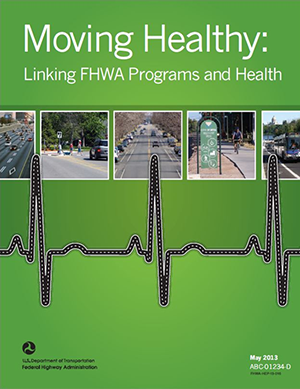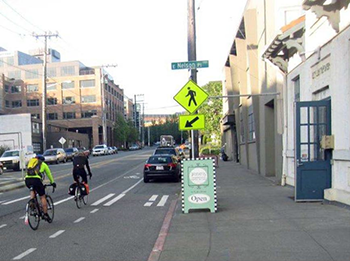
FHWA
Promotes Health in Transportation
Transportation systems can have profound influences on public health through impacts on the environment, communities, public safety, physical activity, and access to vital goods and services. Improvements to air quality through the reduction of vehicle emissions, for example, may help lower rates of heart disease, asthma, and other disorders. The Federal Highway Administration (FHWA) administers programs that protect human and environmental health while meeting the needs of the traveling public. In addition to funding projects that support walking, bicycling, and other active-living opportunities, FHWA has a long history of promoting community health through efforts to prevent traffic injuries and improve air and water quality. In recent years, the Agency has expanded its health-related initiatives to encompass growing disciplines such as environmental justice and access to health-related facilities.
FHWA Initiatives Promote Health in Transportation

FHWA’s Moving Healthy brochure provides an overview of the Agency’s health-related programs and resources. (Courtesy of FHWA)
In 2012, FHWA formed the Health in Transportation Working Group to develop health resources within the U.S. Department of Transportation (DOT) and streamline its approach to health. The Working Group brings together staff from many agencies within the U.S. DOT to inform efforts by FHWA and its partners to address matters of health in transportation. One of the Working Group’s key products is the Moving Healthy: Linking FHWA Programs and Health brochure. The brochure provides an overview of FHWA funding sources most related to health and offers information about existing FHWA programs in several focus areas, including:
Air Quality: Through the principle of transportation conformity, FHWA ensures that transportation planning is consistent with air quality goals under the Clean Air Act, which helps protect the public from harmful pollutants.
Bicycle and Pedestrian Planning: Through the Bicycle and Pedestrian Program, FHWA promotes and facilitates active transportation, like walking and bicycling, which can help prevent weight gain and lower the risk of obesity, diabetes, and heart disease.
Environmental Review: The tools and resources in FHWA’s Environmental Review Toolkit help transportation planning agencies account for the potential impacts of highway projects on the human and natural environments in accordance with the National Environmental Policy Act (NEPA).
Noise: Through its Highway Traffic Noise website, FHWA disseminates noise standards to minimize traffic noise impacts to areas adjacent to federally-aided highways.
Nondiscrimination: FHWA promotes environmental justice and nondiscrimination by avoiding disproportionately adverse impacts on the health of minority and low-income populations. In 2011, FHWA issued Guidance on Environmental Justice and NEPA, which describes the process to address environmental justice during the NEPA process, including the development of environmental assessments and environmental impact statements.
Planning: FHWA administers a Federal transportation planning process that can help communities, regions, and States implement transportation projects and programs that encourage health-related objectives such as promoting active transportation. The Nashville Area Metropolitan Planning Organization’s (MPO) Active Transportation Program is one example of a transportation planning initiative that encourages physical activity in support of health-related goals.
Safety: FHWA promotes the use of life-saving countermeasures to enhance public health and safety on the Nation’s roadways through the administration of the Highway Safety Improvement Program and other initiatives.
Water Quality: FHWA provides information and guidance to transportation agencies to prevent or mitigate the impacts of transportation activities on water quality, including best practices in stormwater management and water quality planning.
Planning for Healthy Communities

The Metropolitan Area Transportation Planning for Healthy Communities report identifies active transportation options, such as bicycling, as a means to increase physical activity and improve health. (Courtesy of FHWA)
FHWA Land Use and Transportation Planning Case Study: Complete Streets Toolkit and Checklist
Mid-Ohio Regional Planning Commission (MORPC)
In 2010, MORPC adopted a Complete Streets policy to ensure that roadways are designed to safely and comfortably accommodate all users. The policy stipulates that all projects receiving Federal funding through MORPC submit a Complete Streets checklist. Considerations on the checklist include transit access, bicycle and pedestrian infrastructure, and connectivity to nearby destinations. The agency also coordinated with five local health districts to develop the accompanying Complete Street Toolkit, which helps local governments understand the connection between Complete Streets and healthy communities.
A recent FHWA publication called Metropolitan Area Transportation Planning for Healthy Communities provides case studies of four MPOs that consider health in their metropolitan transportation planning processes. The report investigates MPOs’ incorporation of public health into transportation planning with a focus on four key areas: active transportation, safety, air pollution, and access to opportunities for healthy lifestyles. The report concludes that MPOs can embed health considerations into the planning process by building partnerships, leveraging available Federal funding, fostering support in the community, and adopting an incremental approach to health in transportation.
A related resource currently in development, the Statewide Transportation Planning for Healthy Communities report, will present insights for State DOTs that choose to integrate public health considerations into their transportation planning and decisionmaking. The study will synthesize trends, lessons, and opportunities based on case studies of DOTs and their partners in five States.
Another useful resource for linking transportation to public health goals is FHWA’s Land Use and Transportation Planning Toolkit. This toolkit offers several brief case studies highlighting coordination between planning and health departments, use of health assessment tools, and advancement of statewide healthy transportation planning. See the text box to the right for an example of the case studies.
Research is currently underway for an upcoming health-related resource: FHWA’s Strategic Initiative Framework for Health in Corridor Transportation Planning. This project, which is in its early stages, will serve as a decisionmaking tool for MPOs interested in taking a more proactive role in improving health outcomes by integrating health considerations into transportation corridor planning and programming. The framework will provide transportation agencies with a set of tools to prioritize and implement specific health-related improvements.
Partnering to Improve Health
In recognition of the transportation system’s impact on health, FHWA and other U.S. DOT agencies are engaged in a number of partnerships that focus on health and related priorities, such as safety, livable communities, and environmental sustainability. The Partnership for Sustainable Communities, for example, is a collaborative effort between the U.S. DOT, the Department of Housing and Urban Development, and the Environmental Protection Agency that promotes approaches to transportation planning that balance transportation needs with protecting the environment. The partnership guides Federal programs and policies according to health-related Livability Principles, including: providing more transportation choices, improving access to basic needs, and investing in healthy, safe, and walkable neighborhoods.
What’s Next for Health in Transportation
Transportation influences health in a variety of ways, due to its impacts upon environmental quality, physical activity levels, safety and personal security, and access to jobs, healthy food and medical care. FHWA and U.S. DOT are committed to improving the quality of life of the American people through guidance and resources that help transportation agencies produce positive health outcomes and better integrate public health into transportation priorities related to traveler safety, environmental protection, and enhanced mobility.
In addition to all the resources recently created or underway, one upcoming U.S. DOT initiative is the Transportation and Health Tool. The Office of the Secretary of Transportation is partnering with the Centers for Disease Control and Prevention to develop this easy-to-use online tool, which will enable State DOTs and MPOs to assess their transportation systems according to a range of health-related transportation performance measures, such as mode share, exposure to vehicle emissions, seat belt use, and use of Federal funding for bicycle and pedestrian efforts. The tool will also help transportation agencies identify opportunities for policy improvements and ways to strengthen collaboration with the public health sector. The tool’s anticipated launch date is fall 2014.
For additional information on future health in transportation initiatives, including the upcoming Statewide Transportation Planning for Healthy Communities report, visit the FHWA Health in Transportation webpage.
Contact Information
Victoria Martinez
Environmental Protection Specialist
Office of Natural Environment
Federal Highway Administration
(787) 771-2524
Victoria.Martinez@dot.gov
Lilly Shoup
Policy Analyst
Office of the Secretary of Transportation
U.S. Department of Transportation
(202) 366-8134
Lilly.Shoup@dot.gov
Look What’s New!
- FHWA and the Federal Transit Administration issued a final rule amending joint procedures that implement NEPA by adding new categorical exclusions for projects within an existing operational right-of-way and projects receiving limited Federal funding. This rulemaking addresses sections 1316 and 1317 of the Moving Ahead for Progress in the 21st Century Act. Click here for more information.
- FHWA will offer an Endangered Species Act (ESA) Webtool Training Webinar on February 19, 2:30-4 PM Eastern. The ESA Webtool is an online tool to streamline preparation of Biological Assessments and the consultation process under Section 7 of the Federal Endangered Species Act for projects where FHWA is the lead Federal agency.
- FHWA recently issued a progress report on the Every Day Counts (EDC) Initiative. EDC is the FHWA’s initiative to advance a culture of innovation in the highway community in partnership with States. The report highlights progress during the year of 2013 of the second round of EDC.
Successes in Stewardship is a Federal Highway Administration newsletter highlighting current environmental
streamlining and stewardship practices from around the country. Click here to subscribe to the newsletter, or call 617-494-3539 for more information.

